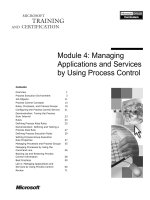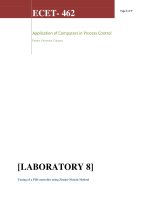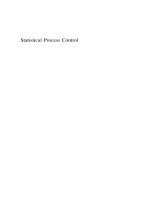Closer Process Control
Bạn đang xem bản rút gọn của tài liệu. Xem và tải ngay bản đầy đủ của tài liệu tại đây (946.03 KB, 17 trang )
Prepared By : Mazadul Hasan
sheshir
ID: 2010000400008
13
th
Batch
Wet Processing Technology
Email:
Southeast University
Southeast University
Department Of Textile Engineering
I/A 251,252 Tejgaon Dhaka Bangladesh
INTRODUCTION:
INTRODUCTION:
Waste water is very similar in textile processing,
which do harms for environment and regular
activities of mankind. Water is used various
textile processes, they are mentioned below-
cleaning the raw material,
many different industrial processes (sizing,
desizing, scouring, bleaching, mercerizing,
dyeing, printing and finishing), and
rinsing steps during the whole production.What is closer process control:
What is closer process control:
Closer process control is a process, which
control the pollution load in textile effluent.
By this process, the pollution load can be
reduced by 30-40percent.
The closer process controlled by
The closer process controlled by
following implements:
following implements:
Reduction in chemical usage.
Recovery and re-use of chemicals.
Process modification.
Flow or volume reduction.
Reduction in chemical usage:
Reduction in chemical usage:
In the finishing operation, the starch is used
in large quantities. The unutilized eventually
joins the effluent stream. Its amount should
be optimized though it is estimated that it
will always remain somewhat in excess of
what is required. Obviously, this excess
should be diverted for different ratio. In
summer it should be sun-dried and in
winters it should be evaporated thus
obtained should be disposed of as solid
waste.
In bleaching operations, chlorine and per
oxides are used. They should be mixed
with dyeing effluent in order to decolorize
it.
In kiering mercerizing processes caustic
soda is used in large quantities. It should be
recycled by readjusting its concentration.
Process modification:
Process modification:
Certain change in processes can reduce the amounts and concentrations
of waste materials. E.g.change in dyeing method(use of Exhaust dyeing ,
Standing bath dyeing , Pad-batch dyeing ).
Exhaust dyeing:
Exhaust dyeing in which a batch of fibre is dyed from a liquor that is
used only once and then discarded. This technique enables dyers to
produce matching colours on different batches of fibre with relative case
(provided that the composition of the dye liquor and the dyeing
conditions are carefully controlled) but obviously leads to the wastage of
chemicals that are not consumed in the dye bath. However, provided
that dyes which exhaust well are used, the loss of dyestuff is negligible
and other chemicals used in the dye bath are relatively cheap.
Standing bath dyeing:
Standing bath dyeing is basically similar to exhaust
dyeing. However, after the first dyeing the dye bath is
replenished with dyestuff and chemicals and a further
dyeing is carried out. This replenishment may be
repeated several times. Experience is required to
calculate the exact amount of dyestuff and chemicals
needed for replenishment.
Pad-batch dyeing:
Pad-batch dyeing is a recently-developed method based
on the use of reactive dyes. It is often carried out in the
cold and uses low liquor to fibre ratios (1: 1 compared
with 20: 1 for exhaust dyeing).
Recovery and re-use of chemicals:
Recovery and re-use of chemicals:
Size selection
Replace starch-based sizes with synthetic sizes.
The advantages of this is a reduced pollution
load as synthetic sizes have lower BOD levels,
and they can be recycled for reuse.
Desizing
The effluent from desizing will contain the sizes
that were added onto the yarn before
weaving/knitting. Using and recycling synthetic
sizes in place of starch sizes will reduce the
pollution load from desizing.
Scouring
Detergents should be easily biodegradable. Avoid
the following detergents: linear alkyl benzene
sulphonate; dialkyl-dimthyl ammonium chloride with
poor biodegradability (e.g. EDTA; phosphonic acid).
Reuse scour wash water for desizing. Recycle
continuous scour wash water to batch scouring.
Bleaching
Replace the use of chlorites and hypochlorite's with
hydrogen peroxide. Ensure that bleaching is carried
out efficiently. Recycle bleach wash water for
scouring. Use vacuum slots to remove excess
solution which can then be reused.
Mercerizing:
Recycling of sodium hydroxide through evaporation
for reuse in mercerizing or scouring will decrease
the pollution load and chemical consumption.
General
Use modern equipment.
Replace batch processes with continuous processes.
Install counter-current washing.
Combine processes such as desizing, bleaching and scouring.
Replace harmful chemicals with those of lower
environmental impact.
Reuse wash water for cleaning equipment and screens.
Flow or volume reduction:
Flow or volume reduction:
The waste flow may be reduced by the
reuse of process water, counter flow
waste, segregation of weak waste for
disposer without treatment, changes in
process and other similar means.
Conclusions:
Conclusions:
The textile industry emits a wide variety of
pollutants from all stages in the processing of
fibers and fabrics. These include liquid effluent,
solid waste, hazardous waste, emissions to air and
noise pollution. It is important to investigate all
aspects of reducing wastes from the textile
industry, as not only will it result in improved
environmental performance, but also substantial
savings for the individual companies.









